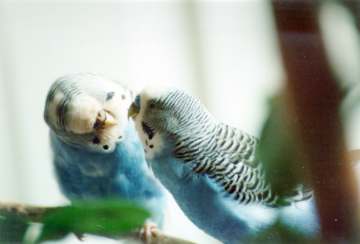So how do you tell boy budgies from girl budgies if they're too young to have different colored ceres? Male budgie behavior is different from female budgie behavior. If you watch the young birds together in a cage at a pet shop, you will notice differences in how they interact.
Male and female budgies like to pair up from an early age, even if they're not bonded pairs.
The males are the ones who bob and bow and hop around, warbling all the while. Females are less likely to make all those burbling noises or bob their heads. The males are the more generally friendly sex, actively trying to make friends with other males and females. Males will do all this friendly behavior to a shiny object or a toy, if they feel like it, especially if there are no other birds around.
If one budgie is feeding another, it is usually a male doing the feeding. Remember that a male may also court or feed another male, especially if there are no females, or if the females are not responsive. So how do you tell if he is bowing and bobbing to a male or to a female? A female will make a little lunge toward the male, leaning toward him and slashing her closed beak downward in his direction, as if to say, "Aw, get out of here!" The male will back off a little, then continue with his courting. If she's seriously not interested, she'll get more aggressive each time she does it. If she is interested, she will just make a token gesture and allow herself to be courted. I have never seen males make that little "get out of here" gesture.
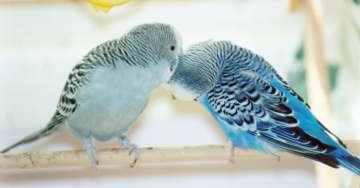 Either partner may preen the other.
Either partner may preen the other.
Females will be vocal in different ways from males. Females may call, a short, loud-ish chirp. But few female do the continuous warbling, burbling sound that the males do. A group of undisturbed budgies will sound like a babbling brook, due to the males burbling away. Although I have seen females do this, it is overwhelmingly a male pastime.
Females are more likey to bite you hard. Of course, if the birds are not tame, and are frightened of human hands, either sex will bite. But the females are more aggressive and short tempered.
Females are generally higher in the pecking order than males. The one who chases another bird off of a perch, away from the food dish, or away from a toy, is probably a female. The one who got chased may be either male or female.
It has been said that males make better pets, and better talkers, than female budgies. It's true, in general. Sure there are some snuggly, friendly, talking female budgies out there. But the males are more likely, on the average, to be friendly and talkative.
 If you want to select a baby budgie of a particular sex, find one that shows as much gender-specific behavior as possible. A budgie that is bobbing and bowing, warbling away, feeding another budgie, acting very friendly, and getting out of the other birds' way, is your best bet for a male. A budgie who is being courted, being fed, making little "get out of here" lunges toward her partner, acting aggressive, and generally ruling the roost, is most likely to be female.
If you want to select a baby budgie of a particular sex, find one that shows as much gender-specific behavior as possible. A budgie that is bobbing and bowing, warbling away, feeding another budgie, acting very friendly, and getting out of the other birds' way, is your best bet for a male. A budgie who is being courted, being fed, making little "get out of here" lunges toward her partner, acting aggressive, and generally ruling the roost, is most likely to be female.
(Another good reason to get a bird that shows as much gender specific behavior as possible is that a sick bird is LESS likely to display any such lively behavior. Healthy birds are MORE likely to act like males or females)

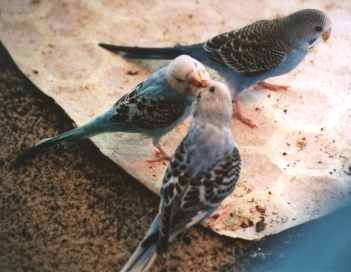
Another factor you can use to help you guess a young bird's sex is that some colors and varieties of budgie are more likely to be female. For instance, the opalines. Opaline means that the black markings are present on the bird's wings, but not on the head or back. The two lower birds in the picture to the left are opaline.
On the average, as many males as females are hatched. But on the average, the females are more likely to look opaline and the males are less likely to look opaline. This has to do with genetics and statistics, and I'm not going to try to explain it here. Let's just say it's a little easier to make a female opaline than to make a male opaline. Thus, there are more opaline females in the world than opaline males.
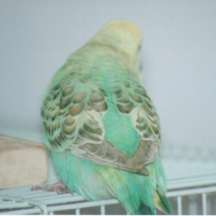 Cinnamon is another trait that is sex-linked, that is, it's easier to make females than males. Cinnamon means that the black markings are brown instead of black. The bird on the left is both cinnamon and opaline.
Cinnamon is another trait that is sex-linked, that is, it's easier to make females than males. Cinnamon means that the black markings are brown instead of black. The bird on the left is both cinnamon and opaline.
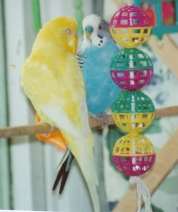
Albino and lutino birds also fall into this category. Albino means the bird is white with red eyes. Lutino means the bird is yellow with red eyes. The yellow bird on the left is a lutino. (It's eyes are red to begin with, and the camera made them redder!)
We've talked a little about the different varieties of budgies, specifically, the sex-linked varieties. What other varieties are there? We'll discuss that on page three.
Take me to educational budgies, page 3.
Take me to Nan & Flock Homepage
This page hosted by ![]() Get your own Free Home Page
Get your own Free Home Page
